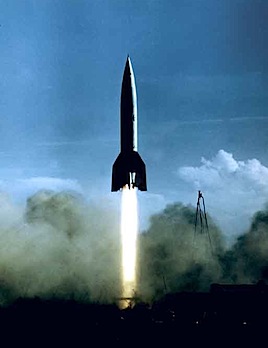The V-2 Rocket
The V-2 rocket, produced by Nazi Germany during World War II, was the first man-made object to achieve suborbital spaceflight and was the precursor to all modern rockets, including those used for human spaceflight. Germany launched over 3,000 of them at Allied countries up through 1945, claiming 7,000 military and civilian lives, mostly in London and Antwerp, as well the 25,000 slave laborers who died while being forced to produce them.
The 46-foot-long rocket's liquid oxygen-fueled engine would burn for only about 65 seconds before cutting off, using two gyroscopes and a simple analog computer to determine the exact angle of the rocket at the moment the engine cut off. The rocket then followed a purely ballistic trajectory the rest of the way to its destination, sometimes landing within meters of its target. The V-2 had a range of up to 200 miles at an altitude of 55 miles.
Whenever the rockets fell in London, there would be no warning before the explosion, as the V-2 traveled at supersonic speeds. Just after the explosion, a characteristic fading whistling sound could often be heard. In fact, the British government denied that the city was under rocket attack until it had been going on for weeks, instead attributing the explosions to other causes.
When Germany fell to the Allied troops in 1945, the V-2's creator, Wernher von Braun, and his whole team surrendered to the Americans in order to prevent their technology from going to the Russians. Von Braun went on to create the rockets first used by the fledgling US space program, including the giant Saturn V rocket that took astronauts to the moon.
